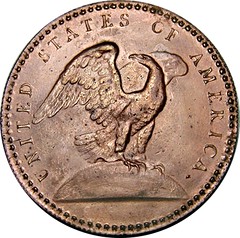
PREV ARTICLE
NEXT ARTICLE
FULL ISSUE
PREV FULL ISSUE
MORE ON THE JOSEPH WRIGHT 1792 PATTERNSteve M. Tompkins submitted the following on the 1792 Wright quarter. He included
an image of the Smithsonian copper example, taken by Dick Doty. Thanks! -Editor
I covered the 1792 Quarter dollar patterns and the reverse die with the border of stars in my book on the bust quarters (published 2008). Please find below the section copied from that book.
On the obverse was an elegant portrait of a young, slender, bust of a woman representing lady liberty as prescribed in the mint act. The word LIBERTY is above and the 1792 date below. Liberty’s hair was bound up with a thin ribbon and is not free flowing. There were no dentils and only a small single star was placed to the right of LIBERTY. On the reverse was an eagle motif (also prescribed by the mint act) with wings open and swept back, perched upon a half globe. (This was perhaps derived from the State Seal of New York first developed in 1778). The legend UNITED STATES OF AMERICA surrounds the central eagle/globe motif. There are 87 small five-pointed stars around the periphery perhaps in lieu of dentils (the significance of the number of stars remains a mystery, as well as the single one found on the obverse). Some previous scholars have postulated a connection between these stars and the ones found on the famous 1794 “starred” reverse die, only seen on the Sheldon-48 Large Cent die marriage. Some have even gone so far as to suggest that they were both produced at the same time and utilizing the same star punch. Most of these theories were put forth when the 1792 pattern quarter was thought to be a pattern for a Large cent. Large cent researcher and author Pete Smith wrote a detailed study in 1986, comparing these two similar dies and came to the conclusion that the stars were not the same size or shape, and were not from the same star punch. The theory of a connection between these dies is just that, a theory. The only similarity comes from the apparent use of a row of stars in place of dentils. The mint did try another type of border on the 1793 Large cents; the beaded border. This experiment and the one utilizing stars was abandoned after 1794 in favor of dentils." I agree with Tom DeLorey - a blank die with stars from 1792 does not make much sense, however it is possible that the starred reverse large cent die was one that Wright was working on when he succumbed to the yellow fever in late 1793. As stated by Dave Bowers, Robert Scot could have then completed it to create the finished S-48 reverse die. Just a thought... To read the earlier E-Sylum articles, see:
Wayne Homren, Editor The Numismatic Bibliomania Society is a non-profit organization promoting numismatic literature. See our web site at coinbooks.org. To submit items for publication in The E-Sylum, write to the Editor at this address: whomren@gmail.com To subscribe go to: https://my.binhost.com/lists/listinfo/esylum All Rights Reserved. NBS Home Page Contact the NBS webmaster 
|
